|  Several
months ago I was fortunate to visit one of my Japanese pen friends.
He retired from the Pilot sales team several years ago, but he has a wealth of
knowledge about old Pilot pens, and I never get tired of hearing his stories.
I first met him at the Tokyo Pen show a year ago, and he was stunned to see
that I had a 1918, first year Pilot pen. When I said I had more early Pilot's
in my
collection at home, he invited me to visit his home some afternoon for coffee
and
to talk pens for awhile. In Japan this happens a lot, people make invitations
out of
politeness, but they rarely have any intention to actually have anyone come to
their
home. Just a weird bit of this culture that I have long grown used to, so I graciously
accepted, never expecting to see him again. Several
months ago I was fortunate to visit one of my Japanese pen friends.
He retired from the Pilot sales team several years ago, but he has a wealth of
knowledge about old Pilot pens, and I never get tired of hearing his stories.
I first met him at the Tokyo Pen show a year ago, and he was stunned to see
that I had a 1918, first year Pilot pen. When I said I had more early Pilot's
in my
collection at home, he invited me to visit his home some afternoon for coffee
and
to talk pens for awhile. In Japan this happens a lot, people make invitations
out of
politeness, but they rarely have any intention to actually have anyone come to
their
home. Just a weird bit of this culture that I have long grown used to, so I graciously
accepted, never expecting to see him again.
A few weeks later, I was surprised when he called me and asked when I was
free. Wow. He was serious. So we made arrangements and I made my way to his lovely
home, pen case in hand. We took turns showing off our pens, and I had to bow my
head in defeat. I do not feel like I am a slouch as a pen collector, but I just
couldn't compete with this guy as he pulled out one Dunhill Namiki after another.
He had a lovely Dunhill Namiki goldfish pen and after holding it for a long time,
I handed it back to him. That was the greatest act of will power I have ever made.
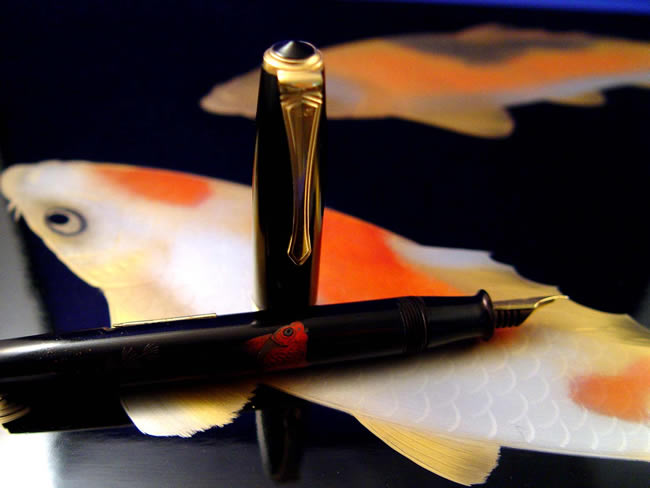
After a spell of answering my questions he pulled out a tattered old manila
folder that had several letters inside written in English. He asked if I would
read these and interpret them for him. They were from the 1930's, and most were
between Pilot and The Chicago Compass Company. The Chicago company wanted to buy
iridium from Pilot to be used in their precision compass points. Sadly these letters
were not very cordial due to a little misunderstanding. In Japanese, people often
use the word "Muzukashii" which roughly translates as "Difficult",
but the nuance is completely different. When American's hear the word "difficult"
they assume that it is possible, but may take a little extra time or effort. However,
when the Japanese use this word, it is basically a very polite way to say "No
way in Hell" I explained this to my friend, and he slapped his head to his
forehead in shock. For 60 years people at Pilot had wondered what the problem
was.
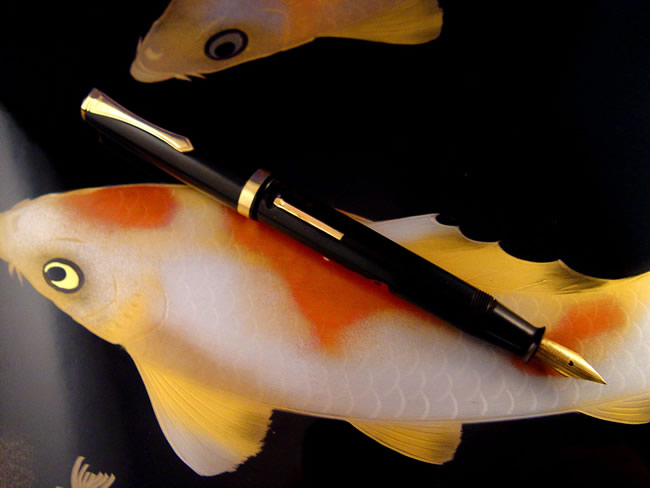
My friend was grateful for my help. He knew I was a big fan of his goldfish
and he made me a generous gift in return for my efforts. Gift is not the
right word, but I can't think of a better one. It was more like a test. He
showed me three maki-e pen barrels. He said I could choose one. One was
very valuable, but the other two were not worth nearly as much.
I remembered the old Indy Jones movie..."Choose, but choose wisely."
I was far too ignorant to choose wisely. I figured the value was in the
signatures, but I did not have these memorized at the time, and I thought it
would be cheating to look them up.
The first barrel was a lovely Goldfish Maki-e. Tons of togidashi gold dust,
actually heavy with it, but the barrel had a tiny crack, and since this was an
eyedropper barrel, I realized what a pain it would be to restore.
The second pen was another goldfish eyedropper and again it was beautiful.
Not as much gold dust, but it had no cracks.
The third pen had the least gold dust, and it had a very subtle feel to it.
The colors were less striking than the other pens, but the barrel was for a
lever filler, and I thought this would be the easiest for me to restore, so
I selected this barrel.
My friend beamed with pride as if his pupil solved a difficult
algebra problem. "You chose wisely," he said.
As soon as I got home, I looked up the pen and discovered why it is so precious.
The signature is that of Enomoto Shoetsu, one of Pilot's grand masters who entered
the company in 1930. He was one of the leading artists for the Dunhill Namiki
pens. I always wanted one of these pens, but never thought I would ever find one,
and if I did, I could never afford it.
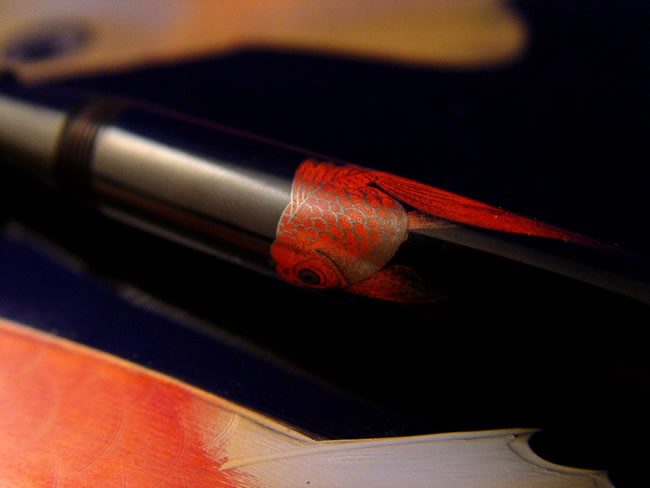
I spent three restless months, searching for parts to complete the pen, and
eventually I got it pretty close to what it would have looked like. The main difference
is that this pen should have a cap with another maki-e goldfish. But this is something
that you just aren't going to find in someone's parts box.
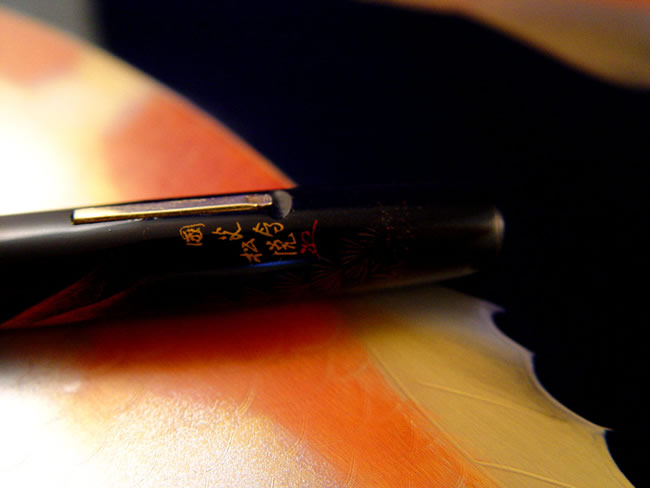
My friend told me later the story behind this pen. The story seems too good
to be true and I wonder how much has been exaggerated, but this is how it
goes.
One summer morning back in 1951, while my friend arrived at Pilot's
Hiratsuka factory he saw Namiki Ryouske, the founder of Pilot.
It was one of the few times that he actually saw Namiki at the factory
and everyone there was tense as Namiki and his upper managers inspected
the factory. They made their way to the Maki-e area and Namiki stopped
in front of Shoetsu and picked up one of the pen barrels that he was working on.
While Namiki was examining the pen he dropped it onto the concrete floor and
this put a tiny crack into the barrel right at the threads. Namiki apologized
and
quickly left. After things settled down, Shoetsu swore something under his breath
and threw the barrel into the trash. Later my friend went back and retrieved the
barrel.
He loved the maki-e pens but as a young salesman he could hardly afford one.
I hadn't even noticed the crack before, but after looking closely with a
loupe, I spotted it. Just a very tiny hairline, but it is there.
I guess a crack in a Pilot maki-e pen is not so bad if Namiki put it there
himself.

Ron Dutcher has lived in Japan for over 15
years, where he owns and runs a small orthopedic clinic with his wife, Keiko;
which leads him to many Japanese pen finds. His patients, once they learn of his
pen hobby often give him pens as gifts or offer to sell them to him. He is a member
of the Tokyo Pen Association, and has learned a great deal from Japanese pen collectors.
He sells a great many Japanese pens on ebay under the name Kamakura-Pens, but
his true love is for early American pens. He can be contacted at rd@kamakurapens.com
Click on the link below to visit http://www.kamakurapens.com
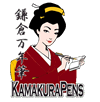
|